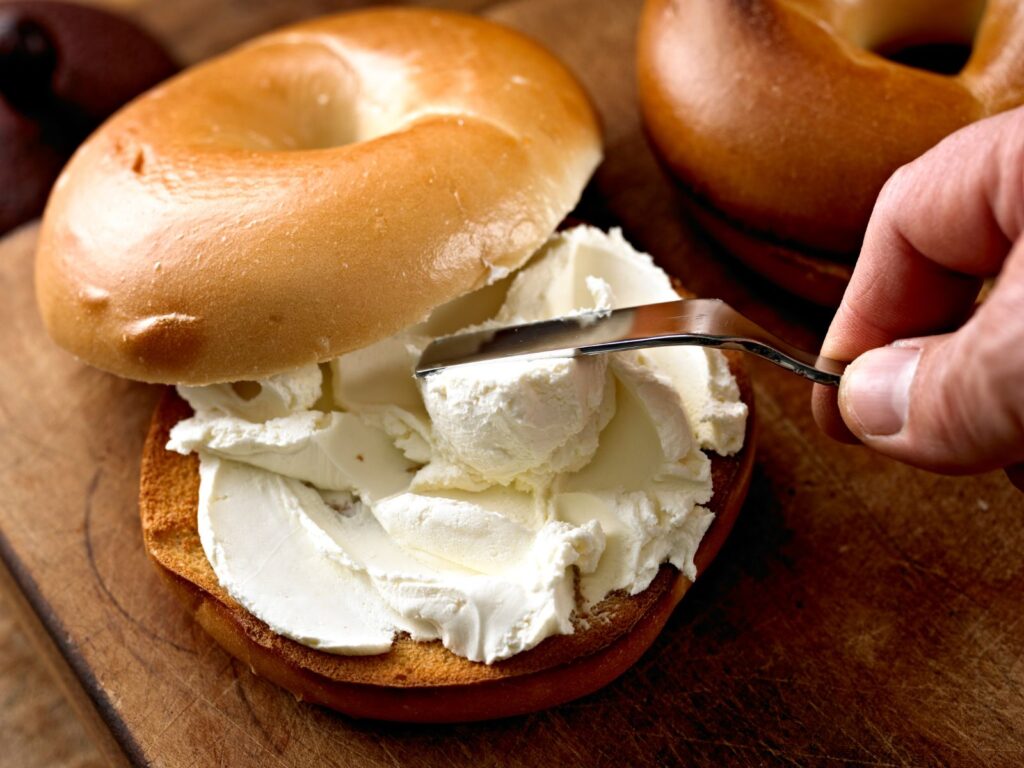Without a doubt, Philadelphia cream cheese is a household name, loved by millions across the globe. It’s a rich, creamy, and indulgent spread that can add a touch of luxury to any meal or snack. In this blog post, we’ll explore the origin, production and flavour profile of Philadelphia cream cheese. We’ll also discuss serving suggestions and some alternative options.

What is Philadephia Cream Cheese?
Philadelphia cream cheese was first produced by a dairy farmer named William Lawrence in 1872. Lawrence lived in Chester, New York, and had been making cheese for over a decade.
He stumbled upon the recipe for Philadelphia cream cheese by accident when he was trying to recreate the French cheese, Neufchâtel. Lawrence’s new cheese was a hit, and he named it after the city where he thought it would sell best – Philadelphia. The popularity of Philadelphia cream cheese grew rapidly in the 1920s and 30s when it was marketed as a versatile ingredient that could be used in both sweet and savoury dishes.
In 1928, the brand was bought by the Kraft Cheese Company, which helped to expand its distribution across the United States. Today, Philadelphia cream cheese is sold in over 80 countries, making it one of the most widely recognized cheese brands in the world.
How is Philadephia Cream Cheese made?
Philadelphia cream cheese is produced in several locations worldwide. However, its origins are firmly rooted in the United States, specifically in the state of Pennsylvania. Today, the cheese is produced in several countries, including the United States, Australia, and Canada.
Kraft Foods is the current owner of the Philadelphia cream cheese brand. They have production facilities across the United States, including in California, Illinois, and Pennsylvania. Kraft also has production facilities in several other countries, including Australia and Canada.
The production process for Philadelphia cream cheese involves mixing cream, milk, and other ingredients, including emulsifiers, stabilisers, and salt. The mixture is heated and then cooled to create a smooth and creamy texture. The cheese is then packaged in blocks or tubs and distributed to retailers.
Flavour profile
Philadelphia cream cheese has a mild and slightly tangy flavour. It’s smooth and creamy in texture, making it easy to spread or mix with other ingredients. The aroma is slightly sweet and fresh.
Serving guide
Philadelphia cream cheese pairs well with sweet and savoury flavours. It’s a popular ingredient in cheesecakes, dips, and spreads. It also works well with bagels, toast, crackers, and fresh fruit.
Some popular combinations include smoked salmon and cream cheese, strawberries and cream cheese, and cucumber and cream cheese.
Alternatives to Philadelphia Cream Cheese
Whether you want a spread or to cook a delicious dessert, you can use either of these three alternatives to this famous cream cheese.
- Mascarpone – Mascarpone is a rich, Italian cheese that is similar in texture and flavour to cream cheese. It’s often used in desserts, including tiramisu and cheesecake.
- Ricotta – Ricotta is a mild Italian whey cheese that is commonly used in Italian dishes like lasagne and cannoli. It has a grainy texture and a slightly sweet flavour.
- Cottage Cheese – Cottage cheese is a fresh cheese that is similar in texture to ricotta. It has a mild flavour and is often used in dips and salads.
Conclusion
Philadelphia cream cheese has been a beloved ingredient for over a century. Its versatility and creamy texture make it a popular choice for both sweet and savoury dishes.
While there are several alternatives to Philadelphia Cream Cheese, its unique flavour and texture continue to make it a favourite among cheese lovers worldwide.
Thank you for reading
Thank you for reading this post about yet another amazing artisanal cheese. Have you tried this cheese before? Drop us a comment below with your thoughts.
If you enjoy learning about new cheeses, you can subscribe to our newsletter below. You will hear from us about once a week as we share new cheese profiles with you.
Finally, keep scrolling to find some more cheeses and recipes that have been recommended for you. Keep it cheesy!



